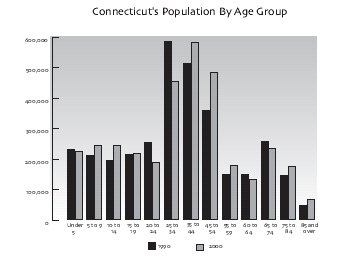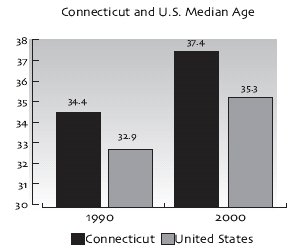
| The Comptroller's Report |
Nancy Wyman - State Comptroller
|
Population Trends
- Census figures show Connecticut's population grew from 3,287,116 in 1990 to
3,405,565 by the year 2000.
- Connecticut's modest 3.6 percent population gain was the fourth lowest
among all states. Only North Dakota, West Virginia and Pennsylvania had lower
population growth rates during the last decade.
- One result of Connecticut's low population growth was its loss of a
congressional seat. Since the apportionment from the 1930 census, Connecticut
has had six seats in the House of Representatives. Connecticut will now send
only five members to the House.
- Connecticut's population has aged over the last decade. The median age for
state residents increased from 34.4 in 1990 to 37.4 in 2000. The country
showed a similar trend but for a somewhat younger population; the national
median age increased from 32.9 in 1990 to 35.3 in 2000.

- The state's younger population -- 19 and under -- grew at a faster rate
than its elderly -- those 65 and over. However, a significant upward shift in
age within the large population group from 20 to 65 accounted in large measure
for the rise in Connecticut's median age.

- Connecticut growing racial and ethnic diversity is also reflected in the
2000 census. All racial categories of the non-white population have increased.
The Hispanic or Latino population, which can be of any race, has also increased.

- Four of Connecticut's five largest cities, those with over 100,000
residents, experienced a population decline during the last decade.
Bridgeport, Hartford, New Haven and Waterbury had an average population loss
of 5.5 percent.
- Of the largest cities, only Stamford showed a population
increase of 8.4 percent. Many of the state's smaller communities experienced
the largest growth rate. Fifty-eight Connecticut towns grew by more than 10
percent last decade. Their average population was 10,300 in 1990 and 11,900 in
2000.
Table
of Contents | Index of Comptroller's
Reports | Comptroller's Home
Page
![]()